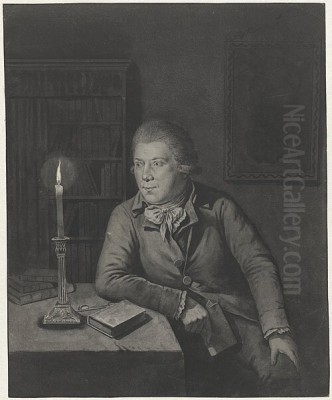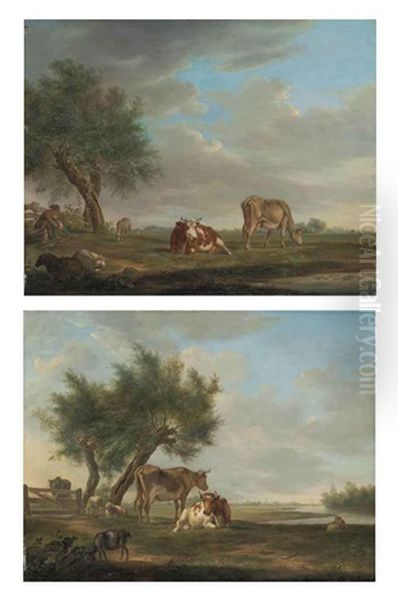
Johannes Janson (1729-1784) was a notable Dutch painter and etcher active during the 18th century. Though perhaps not as globally renowned as some of his Golden Age predecessors, Janson carved out a significant career, contributing to the rich artistic tapestry of the Netherlands during a period of transition and evolving tastes. His work, encompassing detailed landscapes, engaging genre scenes, and proficient etchings, reflects both the enduring traditions of Dutch art and the subtle shifts occurring in European art during his lifetime. Born far from the artistic centers of Europe, his journey to becoming an established artist in the Netherlands is a testament to his dedication and talent.
Early Life and Artistic Formation
Johannes Janson was born in 1729 on Ambon Island, then a part of the Dutch East Indies (modern-day Indonesia). This exotic birthplace was unusual for a European artist of the period and might have subtly influenced his worldview, though his artistic output remained firmly rooted in Dutch traditions. At some point in his youth, Janson relocated to the Netherlands, the heart of a vibrant artistic legacy.
To hone his skills, Janson sought formal training. He became a pupil of Hieronymus van der Mij (1687-1761), a respected painter based in Leiden. Van der Mij himself was known for his portraits and genre scenes, and under his tutelage, Janson would have learned the foundational techniques of drawing, painting, and composition prevalent in Dutch art. Leiden, a prominent university city, possessed a rich cultural environment that would have further nurtured Janson's artistic development. This period of study was crucial in shaping his technical abilities and artistic direction.
Artistic Career and Oeuvre: Paintings
Johannes Janson's painted oeuvre primarily consists of landscapes and genre scenes, themes that had long been popular in Dutch art. He demonstrated a keen eye for detail and an ability to capture the specific atmosphere of the Dutch countryside. His landscapes often feature serene, pastoral settings, meticulously rendered with attention to foliage, architecture, and the play of light.

One of his notable works is "Rural Landscape With Figures," painted in 1777. This oil painting, measuring 39 x 33.5 cm, depicts a tranquil countryside scene. In the background, red-roofed, white-walled houses nestle amongst lush trees, while in the foreground, figures, one notably in a black and white striped top and black trousers, are engaged in rural labor. The composition evokes a sense of peace and the idyllic beauty of country life, characteristic of much 18th-century landscape painting which often sought to present a harmonious view of nature and human activity.
Another significant landscape is "Huis ter Mey Castle," which is held in the collection of the Amsterdam Museum. This work showcases his ability to depict specific locations with accuracy while imbuing them with a picturesque quality. Such paintings catered to a clientele that appreciated representations of their local environment or idealized visions of rural tranquility. Janson's approach to landscape painting followed in the footsteps of earlier Dutch masters like Jacob van Ruisdael and Meindert Hobbema, who had established the genre's prominence, though 18th-century interpretations often carried a lighter, sometimes more decorative sensibility influenced by broader European trends like Rococo.
His genre scenes, though perhaps less documented than his landscapes, would have likely depicted everyday life, continuing a tradition made famous by artists such as Jan Steen or Adriaen van Ostade in the previous century. These works often provided social commentary or simply celebrated the mundane aspects of life with charm and observational skill.
Artistic Career and Oeuvre: Etchings and Graphic Work
Beyond his paintings, Johannes Janson was also a proficient etcher. Etching had a distinguished history in the Netherlands, with Rembrandt van Rijn elevating it to an unparalleled art form in the 17th century. Janson contributed to this tradition with his own skilled graphic works.
His etchings often featured animals, landscapes, and occasionally self-portraits. One of his well-known etchings is "The Cow Seated." This piece, showcasing an animal subject, demonstrates his observational skills and his ability to translate these into the linear medium of etching. The choice of a cow as a subject is deeply rooted in Dutch art, where cattle often symbolized prosperity and the agricultural richness of the land, a theme famously explored by artists like Paulus Potter. Janson's etchings would have been appreciated for their technical skill and their contribution to the diverse range of prints available to collectors. The medium allowed for wider dissemination of images than unique paintings, making art accessible to a broader audience.
His work in etching also included original compositions of landscapes, sometimes populated with animals, further bridging his painted and graphic outputs. The precision required for etching, with its incised lines and controlled inking, complemented the detailed nature often found in his paintings.
Artistic Style and Influences
Johannes Janson's artistic style can be characterized by its careful naturalism, attention to detail, and a generally calm, often idyllic mood. His technique was solid, reflecting the thorough training he received. In his landscapes, there is a clear depiction of space and light, creating believable and inviting scenes. The figures within his landscapes are typically well-integrated, contributing to the overall narrative or atmosphere rather than dominating the composition.
He was undoubtedly influenced by the great Dutch painters of the 17th century Golden Age. The legacy of landscape painters like Jacob van Ruisdael, Aelbert Cuyp, and Meindert Hobbema, and animal painters like Paulus Potter, provided a rich foundation upon which 18th-century artists like Janson built. While the dramatic intensity of some Golden Age works might have given way to a more serene or picturesque sensibility in the 18th century, the core Dutch values of meticulous observation and skilled craftsmanship remained.
The broader European artistic currents of the 18th century, such as the Rococo, with its emphasis on elegance, lightness, and pastoral themes, may also have had a subtle influence on his work, particularly in the mood and composition of his landscapes. However, his art largely retained a distinctly Dutch character. He was less an innovator in the dramatic sense and more a skilled practitioner who upheld and continued the established traditions of Dutch painting and etching, adapting them to the tastes of his time.
Contemporaries and the Artistic Milieu
Johannes Janson operated within a vibrant, albeit evolving, Dutch art world. The 18th century in the Netherlands didn't quite reach the explosive artistic output of the 17th-century Golden Age, but it was by no means fallow. Many talented artists were active, and Janson was part of this continuing tradition.
His teacher, Hieronymus van der Mij, was an important figure in Leiden. Other notable Dutch painters contemporary to Janson, or whose careers overlapped significantly with his, included:
Cornelis Troost (1696-1750): Known as the "Dutch Hogarth," Troost was a leading painter of genre scenes, portraits, and particularly "conversation pieces" and theatrical subjects, often with a humorous or satirical edge. Though his focus differed from Janson's landscapes, he was a dominant figure in the first half of Janson's life.
Jacob de Wit (1695-1754): A highly successful painter of decorative works, particularly ceiling paintings and "witjes" (grisailles imitating stucco reliefs). His style was more aligned with international Rococo and Baroque decorative trends.
Jan van Huysum (1682-1749): A celebrated master of flower still lifes, whose meticulous detail and vibrant colors set a standard for the genre that persisted throughout the century. While Janson didn't specialize in still life, the prevailing emphasis on detailed realism was a shared trait.
Rachel Ruysch (1664-1750): Another highly renowned female flower painter whose career extended into Janson's early life, contributing to the Netherlands' fame for still life painting.
Adriaan de Lelie (1755-1820): A younger contemporary, known for his portraits and genre scenes, particularly depictions of art galleries and collectors, active towards the end of Janson's life and into the next century.
Wybrand Hendriks (1744-1831): A versatile artist who painted portraits, landscapes, and still lifes, and also served as curator of the Teylers Museum in Haarlem. His career significantly overlapped with Janson's later years.
Dirk Langendijk (1748-1805): Known for his drawings and paintings of battle scenes and military life, a specialist genre that continued to find an audience.
Paul Constantin La Fargue (1729-1782): An exact contemporary, born in the same year and dying just two years before Janson. La Fargue was known for his topographical views of Dutch cities and landscapes, often in a delicate, detailed style.
George van der Mijn (1723-1763): A portrait painter who was also a contemporary, working in Amsterdam. His brother, Hieronymus Lapis van der Mijn, was also a painter.
Johannes Jelgerhuis (1770-1836): Though his main activity falls after Janson's death, he represents the continuation of Dutch genre and portrait painting into the early 19th century and was also known for his work related to the theatre.
These artists, among many others, formed the artistic environment in which Janson worked. They engaged in various genres, from portraiture and genre scenes to landscapes and still lifes, catering to the demands of patrons who included wealthy merchants, civic institutions, and private collectors. The art market, while perhaps not as booming as in the 17th century, still supported a considerable number of professional artists.
Legacy and Historical Evaluation
Johannes Janson is regarded as a competent and skilled artist of the Dutch 18th century. He successfully navigated the artistic landscape of his time, producing works that were appreciated for their craftsmanship and adherence to established Dutch pictorial traditions. His landscapes offer charming views of the Dutch countryside, and his etchings, particularly those of animals, demonstrate his proficiency in graphic media.
While he may not have achieved the revolutionary impact of artists like Rembrandt or Vermeer from the preceding century, Janson's contribution is significant within the context of 18th-century Dutch art. He represents the continuation of a strong artistic heritage, adapting it to contemporary tastes without radically departing from its core principles. His works provide valuable insight into the artistic production and cultural sensibilities of the Netherlands during this period.
His paintings and etchings are found in various collections, including the Amsterdam Museum, and continue to be of interest to scholars and enthusiasts of Dutch art. He is a figure who, while not always in the brightest spotlight, played a role in maintaining the vitality of Dutch art through a period of transition, before the more dramatic changes that would arrive with Romanticism and subsequent 19th-century movements.
Conclusion
Johannes Janson (1729-1784) stands as a noteworthy representative of 18th-century Dutch art. From his beginnings in Ambon to his established career in Leiden and other Dutch artistic centers, he dedicated his life to painting and etching. His landscapes, such as "Rural Landscape With Figures" and "Huis ter Mey Castle," and his etchings like "The Cow Seated," reflect a deep appreciation for the natural world and a mastery of traditional techniques. Working alongside a diverse group of contemporaries, Janson contributed to the enduring legacy of Dutch art, creating works that continue to be valued for their skill, charm, and historical significance. He remains a testament to the quiet dedication that sustains artistic traditions across generations.